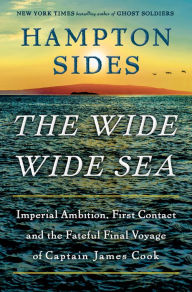How I Found My Way to Captain Cook (Not Captain Hook): A Guest Post from Hampton Sides
The Wide Wide Sea: Imperial Ambition, First Contact and the Fateful Final Voyage of Captain James Cook
The Wide Wide Sea: Imperial Ambition, First Contact and the Fateful Final Voyage of Captain James Cook
In Stock Online
Hardcover
$31.50
$35.00
If you read The Wager and have a hankering for another seafaring adventure, look no further. The Wide Wide Sea details the life and voyages of Captain James Cook, killed by native Hawaiians in an uncharacteristic final act. This is the mystery of Cook’s final days, laid bare in riveting narrative fashion.
If you read The Wager and have a hankering for another seafaring adventure, look no further. The Wide Wide Sea details the life and voyages of Captain James Cook, killed by native Hawaiians in an uncharacteristic final act. This is the mystery of Cook’s final days, laid bare in riveting narrative fashion.
When I was a little kid, my parents bought me an enormous set of comic books called Classics Illustrated. On one of the covers was a swashbuckling image of an Englishman in hand-to-hand combat with a native Polynesian on the palmy shores of some South Seas island. Why were they fighting? I wanted to know more. It was titled “The Death of Captain Cook,” and was supposed to be based on the journals of Cook himself. It was a lurid boyhood fascination, I suppose, but that comic book pulled me in.
Lots of Americans get Captain Cook mixed up with other captains, real and imaginary, like Captain Kidd, Captain Kirk, or even Captain Hook. (I can’t tell you how many people thought I was researching a book about a notoriously mean pirate with a parrot on his shoulder!) But Captain James Cook was the real deal, perhaps the greatest navigator in the Age of Enlightenment. The discipline of his voyages, the quality of his observations, the genius of his maps, and the enormity of the natural science and anthropological understanding he brought back to Europe—few explorers in history can compare. His three odysseys were monumental undertakings that changed the world.
When I began to think seriously about a book on Cook, I quickly saw that as an American writer I really needed to focus on his third voyage. Because it was launched from England in July 1776, just as the American Revolution was igniting. Cook stumbled upon the Hawaiian Islands on his way to the uncharted shores of present-day Oregon. From there, he mapped the northwest coast of the continent and Alaska in search of the fabled Northwest Passage, then returned to Hawaii. So most of the book’s plot transpires in today’s United States. It’s a British voyage but an American tale, through and through.
Yet something was wrong with Captain Cook during this final expedition. His outlook and spirit had distinctly changed. He applied the lash to his own men and became increasingly cruel to the Indigenous people he encountered. He was mercurial, often in pain, and suffered from despondency and flashes of temper we might diagnose as bi-polar disorder today. He may also have had a parasite from the weird foods he’d eaten that sapped his energy and prevented the absorption of B1 and other vitamins.
Whatever was plaguing him, there’s no denying the astonishing breadth of his travels—he sailed over 100,000 nautical miles during his third voyage alone. I believe it’s important to visit the places you write about, to walk the same terrain your characters walked. When you see a place, you can write those passages with so much more specificity and confidence. I did more travel for this book than for all my other books combined—including trips to New Zealand, French Polynesia, Vancouver Island, Alaska, Hawaii, and so many other places Cook visited—and, along the way, spent a lot of time in the relevant archives, too. I went to Cook’s birthplace in Yorkshire, and to the place of his death in Hawaii.
The book’s action funnels down to his time at Kealakekua Bay on the Big Island of Hawaii and the dark and complicated circumstances that led to his death. His time there was like a grand passion play with a catastrophic climax. Did he deserve it? Had karma finally caught up with him? Many people think so. Today, when you go down to the site of his death, you can still feel the shockwaves.
In recent years, we’ve come more fully to recognize the devastating effects of colonialism and the racism that fueled the imperial mindset. The Wide Wide Sea is a product of this reckoning. I questioned the underlying goals and assumptions of Cook’s voyage and used a lot of Indigenous oral history to try to make it a three-dimensional account. Wherever it seemed relevant, I let present-day debates infuse the narrative. It’s a tale nearly 250 years old, yet to me it feels quite modern.
Partly because of this larger reckoning, Cook has become controversial today, and he’s in the news again. His statues have been vandalized and torn down, from Melbourne to Victoria, BC, where protesters recently toppled a Cook monument into the harbor. The people of the Cook Islands are discussing changing their country’s name. I began to research this book during this gathering antipathy toward Cook. For me, all of this controversy is a live wire. It means this old tale still has a pulse.
When you can find a historical subject that still agitates and animates people hundreds of years later, then I say, run towards it.
